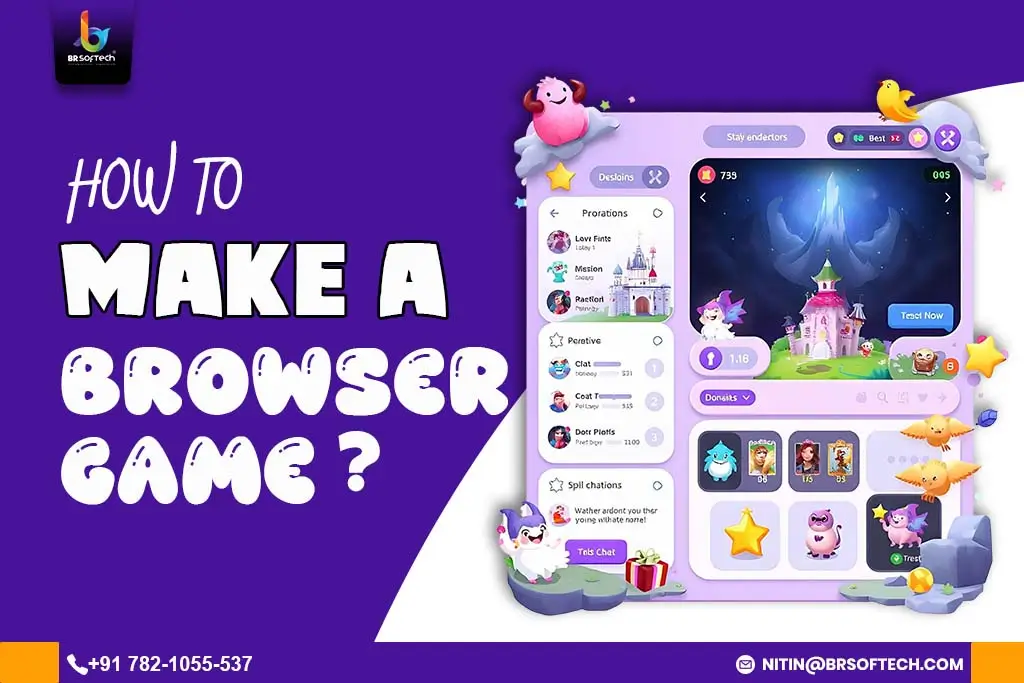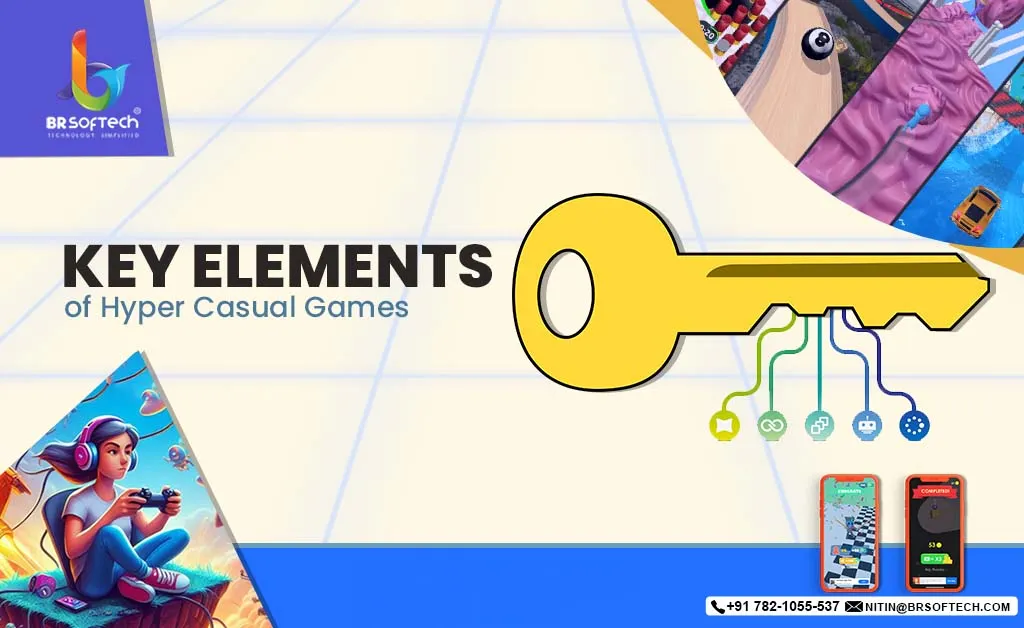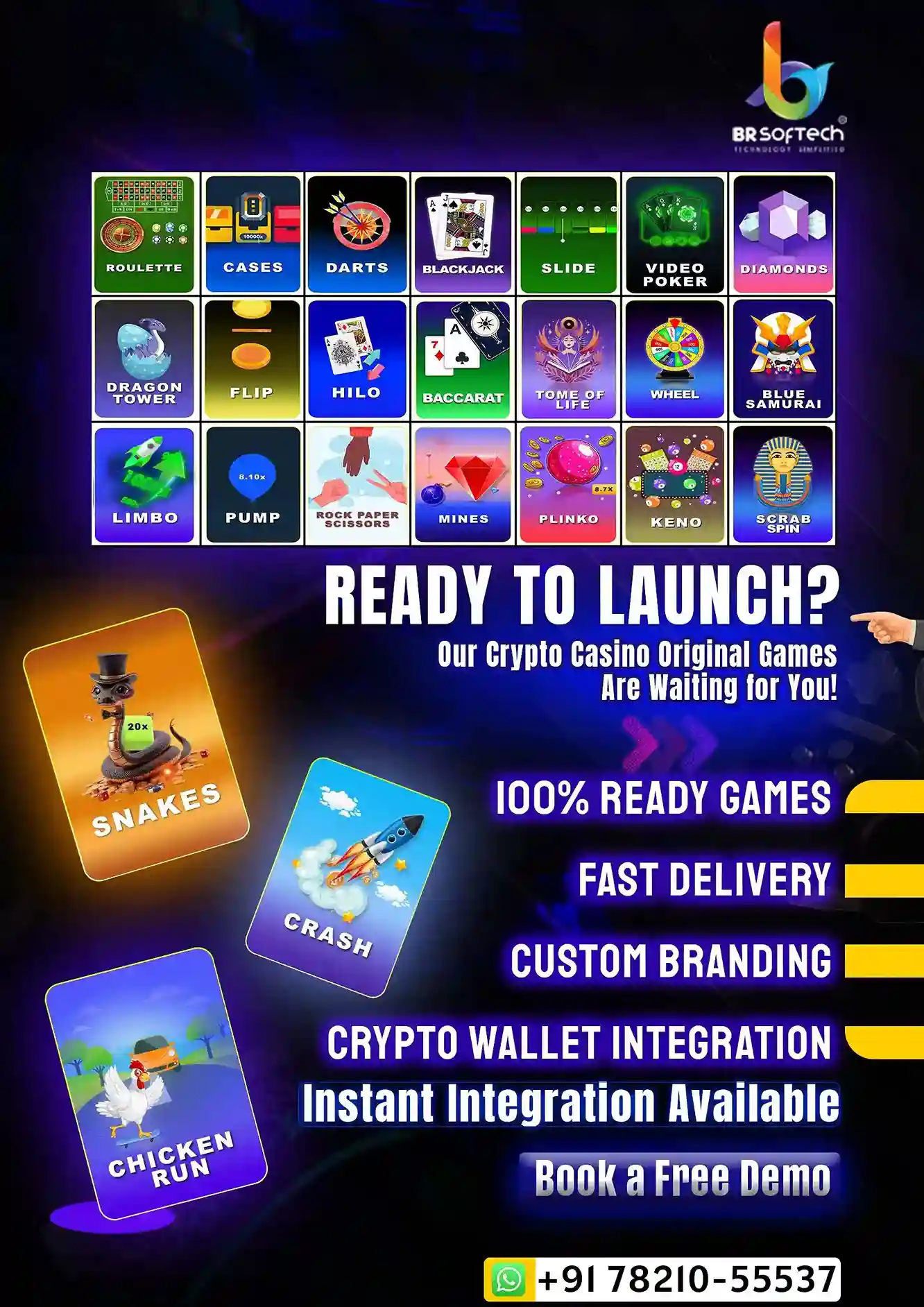Browser games are quietly taking over the gaming industry. Unlike traditional PC or mobile games, they don’t need long downloads or heavy storage space. Just a web browser and the internet. This makes them incredibly easy to access and share.
The rise of hyper-casual games has added to this trend. These are games with simple rules, short play sessions, and instant fun. They are perfect for busy users who want entertainment on the go.
If you are looking for” how to make a browser-based game” or “how to make a web browser game”, this blog is for you! Let’s explore how you can make such a game, but before that, let’s grab some details about what a browser game is.
What is a Browser Game?
A browser game is a game that runs directly on a web browser. Players don’t need to install any software or apps. These games usually load instantly and can be played on different devices, desktop, laptop, tablet, or smartphone.
Many successful browser games fall into the hyper-casual category, meaning they are easy to play, lightweight, and fun enough to make players return again and again.
For entrepreneurs exploring why invest in hyper-casual games, browser-based formats present an exciting low-barrier opportunity to attract a global audience.
For game entrepreneurs, browser games are a smart choice because:
- They offer instant access without downloads.
- They work across multiple devices, including PC, tablet, and mobile.
- They can reach a wider audience globally.
- Their viral nature helps them spread quickly through social sharing.
Principles of Hyper-Casual Browser Game Design
To succeed with a browser game, simplicity is the key. Here are some design principles often used in hyper-casual browser games:
- Simple core gameplay: The main action should be easy to understand (tap, swipe, drag).
- Short but addictive loops: Players should be able to complete a game round in seconds but feel motivated to replay.
- Minimalist design: A clean user interface and quick feedback make games more engaging.
- Device-friendly: The game should work smoothly across different browsers and screen sizes.
These principles not only make the game enjoyable but also help it spread faster among users.
Designing the Game Mechanics
Game mechanics are the base of your browser game. It means how players interact with the game and how they engage. For browser-based and hyper-casual games, the focus should be just simplicity and instant fun. Players should be able to understand the game in seconds without needing tutorials.
1. Common controls
Simple actions like tapping, swiping, or dragging are best because they work across desktops, tablets, and mobiles. These controls feel natural and reduce the learning curve.
2. Responsive input
The game should react quickly to users’ actions without lag. A delay can quickly frustrate users. A quick and smooth response gives satisfaction to users.
3. Real feedback
Adding real-time feedback like animations, sound effects, or score updates creates a rewarding experience. Even small details, such as a vibration on a mobile or a glowing effect on one tap, can make the gameplay addictive.
When comparing mechanics, one can see how companies like Voodoo, the leading hyper-casual game company have mastered creating intuitive yet addictive experiences.
Creating Game Levels
When you are searching for “how to make a browser game,” you must also know that creating game levels is an integral part. The structure of your game levels decides how long players stay engaged. For browser games, level design should be lightweight yet rewarding.
1. Short vs. Endless levels:
Some games work best with short levels that last less than a minute. These give players a sense of achievement and encourage them to play “just one more round.” On the other hand, endless levels like running or survival modes keep players hooked for longer sessions, competing against their own high scores.
2. Smart Progression:
The difficulty level of the game should increase gradually so that users don’t get frustrated. Start simple, then slowly increase the challenge as players improve. This makes the game exciting and suspenseful.
3. Replay Value:
Adding variety and replay value is also important. Many successful browser games use procedural generation, which automatically creates new layouts or obstacles. This means every play feels fresh, even if the core idea is the same.
A well-balanced level structure can transform a simple concept into a highly addictive game. It keeps the players engaged while also challenging the more competitive audience. This is how a web-based browser game must be designed for long-term success.
This approach is also influencing the rise of hybrid-casual games, which blend hyper-casual simplicity with deeper mechanics to enhance long-term engagement.
Optimizing User Experience Across Browsers and Devices
Not all players use the same browser or device, so your game must deliver a smooth and consistent experience everywhere.
● Responsive design
Your game should automatically adjust to fit different screen sizes, from large desktop monitors to small mobile screens, without breaking the layout or visuals.
● Touch-friendly controls
On mobile browsers, buttons and gestures should be easy to use, with enough spacing to prevent accidental taps or swipes.
● Performance checks
Test your game on both high-end and low-end devices to ensure fast loading, minimal lag, and smooth animations for every player.
By focusing on these aspects, you make the game accessible, enjoyable, and engaging for a wider audience.
Testing and Improving Your Browser Game
Testing the game is extremely critical. Any mistake in the game can become a point of embarrassment for you, and players can leave. Here is what you should do:
- Playtesting: Test the game with a different group of players and take their feedback.
- Track important metrics: Look at the average playing time, number of repeat players, number of repeat players, and where players leave.
- Improve the game: Use the feedback to improve the game in short cycles rather than waiting months for big updates.
This approach ensures your game is both error-free, fun-filled, and exciting at launch. Playtesting, tracking metrics, and continuous improvement are strategies already shaping the future of hyper-casual games in the gaming industry, where speed of iteration determines success.
Publishing and Hosting Your Browser Game
Once your game is developed, the next step is publishing it online so that players from across the globe can access it. Browser games are easy to host and share compared to apps. Here is how to publish your browser game online:
● Popular hosting platforms
Services like GitHub Pages, Netlify, and Itch.io let you upload your game and make it live in minutes. They are cost-effective, beginner-friendly, and widely used by indie developers.
● Faster loading
Players don’t like waiting. By compressing game files, optimizing images, and reducing heavy scripts, you can make your game load almost instantly, which helps retain users.
● Easy sharing
Unlike apps that require app store downloads, browser games can be shared with a simple URL link. You can also embed them into blogs, gaming portals, or social media posts for wider reach.
The easier you make it for players to access and share, the faster your game will become popular and build a loyal audience. In fact, integration with blockchain and NFTs is opening a new frontier, with hyper-casual Web3 games emerging as an exciting innovation in the industry.
Monetization Strategies for Browser Games
A great browser game isn’t just about fun; it should also generate revenue. Here are the most common ways to monetize your game:
● Place Ads
You can place banners, pop-up ads, or rewarded ads where players watch short videos to get in-game bonuses. These work well for free-to-play browser games with a large audience.
● Microtransactions
Players can pay for extra features like new skins, upgrades, or bonus levels. Since browser games are lightweight, these purchases are usually small but can add up over time.
● Partnerships
Work with ad networks or popular game portals to expand your reach. These platforms promote your game to wider audiences. They also share ad revenue ot offer distribution deals.
The right monetization model depends on your game type and target audience. There are many successful browser games that combine two or more methods to maximize profitability. Developers can explore detailed insights on hyper-casual game monetization models to identify the most profitable strategies for browser-based gaming.
How BR Softech Can Help You Build a Browser Game
At BR Softech, we specialize in hyper-casual and browser-based game development. We take care of all your needs from coding, testing, to launch. We offer tailored solutions to your business:
Our services include:
- Game concept design
- Cross-browser development
- Level design & gamification strategies
- Monetization setup
- Post-launch support & scaling
If you are planning to enter the gaming industry with a browser game, our team can help you turn your idea into a profitable reality. Contact us today for a free consultation on your project and get a free cost estimate.
Your search query of how to make a browser game ends with BR Softech.
Final Words
Browser games are not just what they used to be; they are shaping the future of casual gaming. Their instant accessibility, cross-platform reach, and viral potential make them a powerful business opportunity.
With the right concept, design, and development partner, you can launch a browser game that not only entertains but also generates consistent revenue.
Frequently Asked Questions
Q1. Can browser games make money? Ans. Yes, browser games can generate revenue in multiple ways. The most common methods include banner ads, rewarded ads, in-game purchases like skins or upgrades, and partnerships with gaming portals or ad networks.
Q2. How much does it cost to develop a browser game? Ans. Making a browser game can cost anywhere between $1,500 to $50,000+, depending game’s complexity, features, and design. A simple hyper-casual browser game may cost less, while a feature-rich or 3D browser game can be more expensive.
Q3. Are browser games still popular in 2025? Ans. Yes, browser games are growing in popularity. Their instant access, no-download model, and compatibility with both desktop and mobile devices make them attractive. The increasing popularity of hyper-casual games has further increased their reach.
Q4. What technology is best for building a browser game? Ans. Most browser games today use HTML5, JavaScript/TypeScript, and WebGL. Popular frameworks like Phaser, Pixi.js, and Three.js help speed up development and improve performance.
Q5. How long does it take to make a browser game? Ans. Development time depends on the project. A simple hyper-casual browser game may take a few weeks, while a more advanced game with multiple levels or multiplayer features can take several months.
Q6. Where can I publish a browser game? Ans. Browser games can be published on platforms like GitHub Pages, Netlify, or Itch.io. They can also be shared via a simple web link, embedded into blogs, or featured on gaming portals.
Q7. Why should a business owner consider making a browser game? Ans. Browser games are cost-effective, easy to distribute, and can reach a global audience without requiring downloads. They also support quick marketing campaigns, brand promotions, and monetization through ads or microtransactions, making them a smart investment for businesses entering the gaming space.










